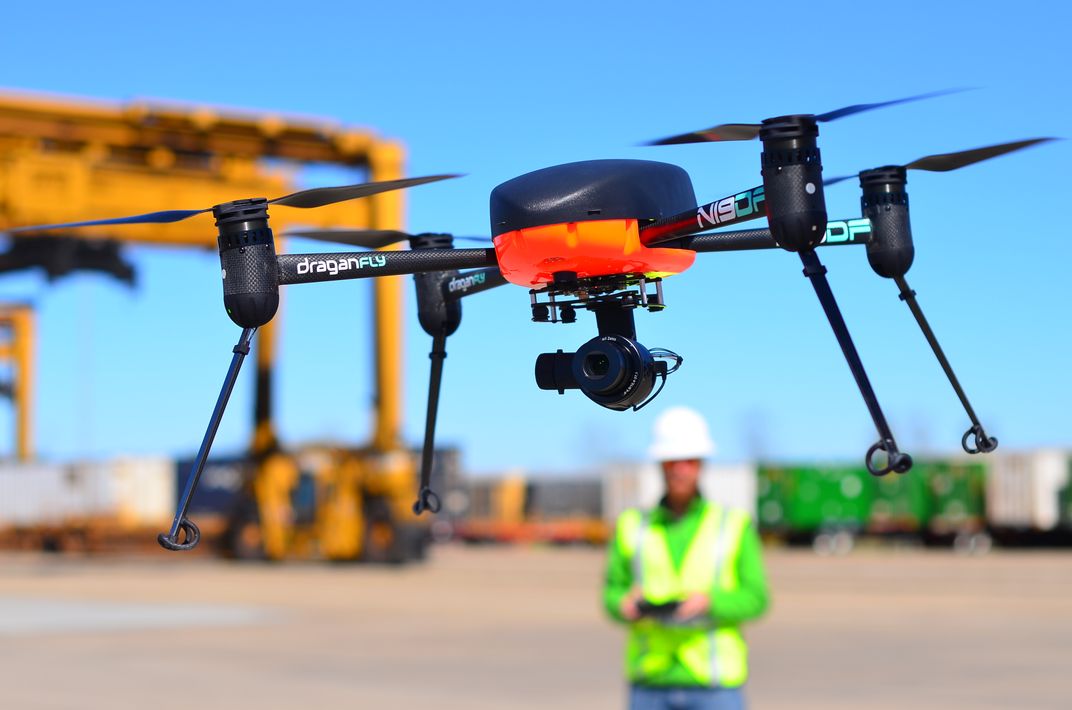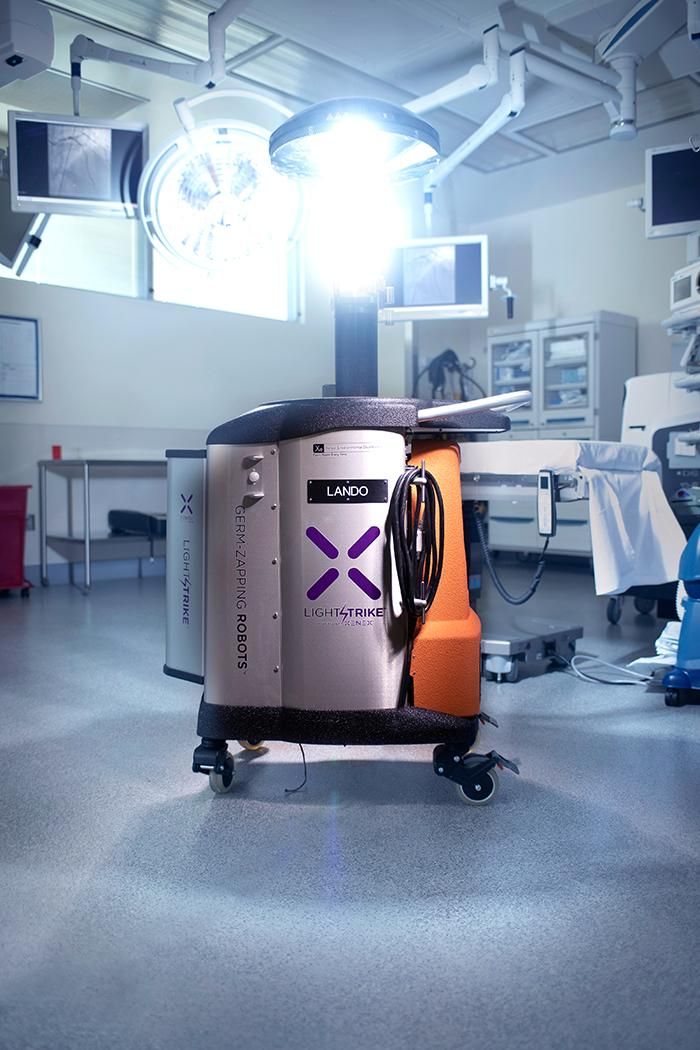How Innovators Are Adapting Existing Technologies to Fight COVID-19
Engineers around the world are tweaking drones, robots and smart tools to help prevent the spread of the virus
/https://tf-cmsv2-smithsonianmag-media.s3.amazonaws.com/filer/26/93/269338e6-513e-482e-86f9-801a7bb94c84/draganfly_drone-main.jpg)
As the COVID-19 pandemic wreaks havoc globally, having claimed more than 115,000 lives by now, the research community is finding novel ways to contribute to the global response against the crisis. Many universities are building DIY ventilators, face masks and face shields for healthcare providers. Others have created sophisticated tracking tools to map out epidemic hotspots.
On the other hand, some ingenious innovators around the world are realizing their existing products could, with a little tweaking, address various challenges posed by the novel coronavirus. Think of it as tech recycling. In fact, these devices might even help to prevent future pandemics and revolutionize health care, if scaled up and adopted widely.
More than a clever hand-washing manual
In India, where COVID-19 cases are still hovering in the 9,000 to 10,000 range—but are estimated to rise to 2.2 million in the worst-case scenario by one projection—an emerging tech tool reinforcing hand-washing could prove beneficial. Developed by social innovation engineer Kanav Kahol, Miaza Mirror is a smart mirror that can detect the presence of a person as soon as they wave at it, and then it walks them through the multi-step hand-washing process recommended by the WHO in a 35-second animated video.
Kahol, who is the co-founder of the New Delhi-based firm Pink Tech Design and an adjunct professor of biomedical informatics at Arizona State University, has a stellar history of building healthcare marvels, such as a virtual reality simulator that allows surgeons to perform cognitive and psychomotor warm-up exercises before surgery.
Kahol launched Miaza Mirror, which detects human presence with a help of a gesture-based sensor, in 2018. Initially, he envisioned it to be a smart mirror, along the lines of smart phones, smart speakers and smart TVs, that people could tune into to get news, send emails or even take selfies. It’s currently being used in offices, especially in entrance areas where it engages visitors with company advertisements. But, soon enough, he was brainstorming its health implications. "[The idea] really came with my kids, as we all often tell them to wash their hands and brush their teeth," says Kahol. "But when they're doing it in front of the mirror, for them it's a very nice, timed way of going about it." Apart from hand-washing, the "health mirror," as Kahol calls it, could potentially be used for breast self-examination and even reminding the user to take their medication.
Kahol started to develop the "health mirror" after the COVID-19 outbreak. Handwashing is one of the primary ways to prevent the spread of the novel coronavirus. In India, where only 35 percent of households clean their hands before eating, getting people to change their hygiene habits can be a marathon task. "The problem with behavior change is that it is actually a very slow process," explains Kahol. "[The behavior] needs to be reinforced every time. So this idea that 'I can just produce a pamphlet and [behavior change] will happen' doesn't work." The mirror, he claims, could reinforce the hand-washing habit, especially since users don't have to rely on their memory to remember each and every step of the complex process.
A small, as-yet unpublished study conducted by Kahol found that 98 percent of people complied with the WHO handwashing protocol when they followed the mirror's instructions—in contrast to a control group, who only saw an instructional video, where the compliance rate was 43 percent.
Since January, Kahol has been frenetically seeking licensing partners and a potential collaboration with the Indian government for the version of Miaza Mirror focusing specifically on handwashing. "As they say, 'You never let any great crisis go to waste'," says Kahol. "This is an opportunity to really change how people think and plan their actions around sanitation."
He envisions public restrooms around India—and even the globe—benefiting from his mirror. "Every public level restroom is today considered to be a cesspool of germs, but we can create it into a cesspool of opportunities by showing people how to wash their hands," he says. The mirror costs 30,000 rupees, or $400.
Kahol says the "health mirror" will find use in the post-COVID-19 world too, even after lockdowns in India and rest of the world are eased. "The world has changed," says Kahol. "The idea of sanitation and the correct handwashing protocol isn't a desirable anymore, it's a requirement."
The pandemic drone
In Australia, Javaan Chahl, a professor of sensor systems at the University of South Australia, is working in collaboration with Canada-based drone tech firm Draganfly to create a drone-based system that could help local authorities around the world identify or predict COVID-19 hotspots.
Chahl started to work on the software—a one-of-a-kind computer vision technology system—that now powers the drone system back in 2014. Initially, his team explored using the technology for measuring vital signs in premature babies. "The idea was to replace some of the invasive instrumentation that currently exists for neonatal babies," Chahl says, referring to adhesive electrodes. They also demonstrated this tech's potential use in disaster relief missions. An October 2019 study in the journal Remote Sensing found that his computer vision system could successfully detect—from 4 to 8 meters above the ground—signs of breathing in humans. The system can also discover living people buried under debris.

The computer vision system can measure heart rate of people based on changes in their skin tone. Heart beating causes variation in blood flow in the face and other places in the body. "It's very subtle signal but [the system] can see it," says Chahl. Beyond that, the system detects breathing/respiratory signals by detecting cyclic movements of the chest. These features use traditional signal processing technology.
As SARS-CoV-2 started ravaging China and other countries, Draganfly inked a contract with the University of South Australia to integrate Chahl's software into its drones. "Until now it was much more about image processing than the drone itself," says Chahl. "That changed when the virus started to appear."
Chahl's team is working on adding two additional features to bolster the computer vision system. One of them is temperature detection. "We're looking at using a thermal camera because people are radiating heat all the time," says Chahl. "The hotter they are, the higher the temperature will register." In addition, a deep learning-based gesture sensor will help the system detect people's coughing and sneezing movements—two very visible signs of a respiratory illness. "That is useful information to understand where the virus might be," says Chahl. "So it's really mapping the human landscape looking for the virus."
Draganfly plans to integrate Chahl's computer vision technology onto remote camera systems as well as drones. The stationary cameras could potentially help hospitals and care facilities to monitor their premises. Drones, on the other hand, could watch over public events such as football matches. "It's all about resource management," says Draganfly CEO Cameron Chell. He says it would help local authorities map out hotspots, so that resources could be deployed in those areas.
The company is hoping to roll out the stationary cameras and drones in the next two to three months. The technology would also function on non-Draganfly drones as cheap as $1,500, says Chell.
He adds that the technology can help monitor future outbreaks of respiratory diseases and even other illnesses. "So we see this technology having the potential to be installed on thousands of drones and millions of camera networks," says Chell."It can be used as as part of a global early warning system, so population health can now become just one of those additional pieces of data that people are looking at."
Addressing concerns around privacy issues that may inevitably arise from this technology, Chell says, "It's not our intent for people to be singled out. The idea here to just provide data so that the policy can be set and actions can be taken on a broader basis."
Disinfection warriors
In the United States, where SARS CoV-2 has infected more than 550,000 people, Xenex, a San Antonio, Texas-based firm that provides hospitals with disinfection robots is scaling up manufacturing to empower facilities in the country and globally to wipe out the virus from their premises.
Many of Xenex's customers have quickly adapted to the pandemic. "Many hospitals have closed elective surgery, so any robots that were were disinfecting ORs have been redeployed into the emergency department or into the COVID testing area," says Mark Stibich, Xenex co-founder and Chief Scientific Officer.

Lauched in 2011, their LightStrike robot’s pulsed xenon lamp shoots intense UV light in millisecond flashes, deactivating a whole range of microbes, including bacteria, spores, fungi and viruses. The UV light's 200 to 300 nanometer wavelength range targets different cellular processes in germs, hampering their replication and causing breakdown of the cell wall. In an April 2019 study in American Journal of Infection Control, the researchers found that rates of Clostridium difficile infection in a Mayo Clinic facility plummeted by 47 percent during six months of disinfection by LightStrike.
In the wake of the pandemic, the company is experiencing unprecedented demand from not only hospitals, but also places like hotels, police stations and government buildings. "With COVID-19, the public's attention on infection and infection control is quite high right now," says Stibich. "So they're asking questions that they perhaps didn't ask before: How is this area disinfected? How do I know that this place is safe for me?"
Xenex's San Antonio facility is busy producing robots to meet the massive demand globally. "We're hoping to scale into thousands per month in the short term," says Stibich. "I could certainly say that no one's taking the weekend off."
Stibich says LightStrike, which costs $125,000 per unit, would be effective in make-shift hospitals like train coaches and football stadia as well. In fact, he stresses, it's much needed there. "I'm just concerned there's a lot of improper disinfection, especially at a place like that which has been set up very quickly and the personnel who are cleaning it may or may not be familiar with healthcare level disinfection," says Stibich. There are other advantages too. "If you have a robot with which you can turn electricity directly into disinfection, you don't need to store chemicals or worry about chemicals being shipped," says Stibich. Xenex is also providing remote training to its new customers, as lockdowns around the world have limited the mobility of its staff.
Now, the million dollar question: Will LightStrike be able to zap out the novel coronavirus? Yes, says Stibich. The U.S. Environmental Protection Agency is currently approving disinfectants based on their efficacy against certain surrogate viruses. Stibich says LightStrike has been tested against two surrogates on that list: MERS and canine parvovirus. Since UV light is regulated by EPA under the "pesticidal device" category, LightStrike isn't on the “disinfectants” list.
Stibich says emerging tech tools like his disinfection robots could pave a better future for health care in general. "The same resources that will let us respond to this pandemic and make us ready for the next pandemic can also work every day," says Stibich, referring to hospital-associated infections and antimicrobial resistance that plague healthcare facilities around the world.
COVID-19 has brought insurmountable suffering to humankind, but it has also propelled innovators to push their creative boundaries for the betterment of the world. "It's very important to realize that necessity is the mother of invention," says Kahol. "It's very important that we do not get depressed, that we do not just think about all the negatives, but actually continuously innovate until we have a fighting chance."